 vuex入门
vuex入门
# 1 vuex 概述
目标:
- 了解vuex的应用场景 (在哪用)
- 掌握vuex的基本使用 (怎么用)
vuex 是一个 vue 的状态管理工具, 状态就是数据
vuex是一个插件工具,可以帮我们vue管理通用的数据
之前如果要进行跨组件的数据通信 => 父传子,子传父 => 一旦组件关系复杂,数据非常难以维护
# 1.1 回顾-组件之间共享状态 (组件通信方案)
默认组件的数据, 是独立的, 每个组件有着自己的状态(数据)
状态 === 数据
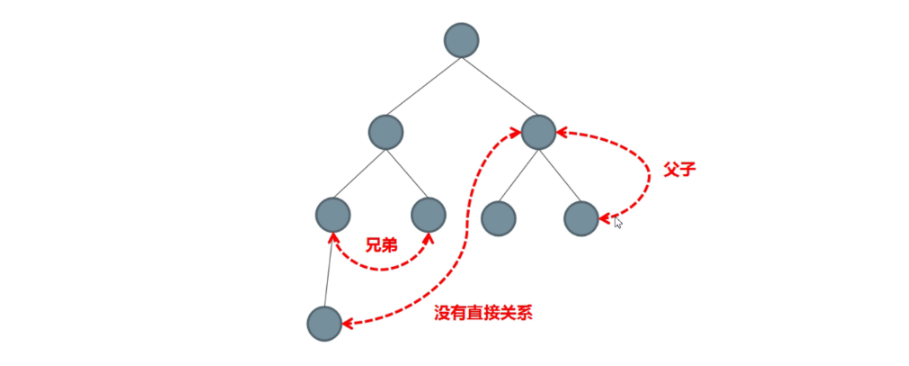
组件之间共享状态的两种典型方式:
父子之间 :
props + $emit父传子:props属性绑定
<son1 msg="msg"></son1>1子传父:
$emit事件绑定<div> <button @click="$emit('event-name')">通知父组件</button> </div>1
2
3
如果某个状态需要在很多个组件来使用,或者要实现多个组件共同维护一份数据又应该怎么做呢 ?
这里就要引入Vuex了。
# 1.2 vuex基本概念
vuex是vue的状态管理工具,状态即数据。 状态管理就是集中管理vue中 通用的 一些数据
注意(官方原文):
- 不是所有的场景都适用于vuex,只有在必要的时候才使用vuex
- 使用了vuex之后,会附加更多的框架中的概念进来,增加了项目的复杂度 (数据的操作更便捷,数据的流动更清晰)
Vuex就像《近视眼镜》, 你自然会知道什么时候需要用它~
# 1.3 vuex的优点: 方便的解决多组件的共享状态
vuex的作用是解决《多组件状态共享》的问题。
它是独立于组件而单独存在的,所有的组件都可以把它当作 一座桥梁 来进行通讯。
特点:
- 响应式: 只要仓库一变化,其他所有地方都更新 (太爽了!!!)
- 操作更简洁
代码量非常少, 但是需要熟悉

# 1.4 什么数据适合存到vuex中
一般情况下,只有 多个组件均需要共享的数据 ,才有必要存储在vuex中,
对于某个组件中的私有数据,依旧存储在组件自身的data中。
例如:
- 对于所有组件而言,当前登陆的 用户信息 是需要在全体组件之间共享的,则它可以放在vuex中
- 对于文章详情页组件来说,当前的用户浏览的文章列表数据则应该属于这个组件的私有数据,应该要放在这个组件data中。
# 1.5 概述小结:
- vuex解决什么问题? vuex 能解决 多组件共享数据 的问题, 非常方便便捷
- 什么样的数据, 适合存放到vuex? 多组件的 通用 的共用数据, 适合存到 vuex
vuex 两大优势:
- 响应式变化
- 操作简洁 (vuex提供了一些简化语法的辅助函数, 这些辅助函数, 需要熟练掌握)
# 2 vuex入门
# 2.1 需求: 多组件共享数据
对于如下三个组件(一个父组件,两个子组件)

效果是三个组件共享一份数据:
- 任意一个组件都可以修改数据
- 三个组件的数据是同步的
1 创建项目
vue create vuex-demo
2 创建三个组件, 目录如下
|-components
|--add-item.vue
|--sub-item.vue
|-App.vue
2
3
4
3 源代码如下
App.vue在入口组件中引入add-item和sub-item这两个子组件
<template>
<div id="app">
<h1>根组件</h1>
<input type="text">
<add-item></add-item>
<hr>
<sub-item></sub-item>
</div>
</template>
<script>
import AddItem from './components/add-item.vue'
import SubItem from './components/sub-item.vue'
export default {
name: 'app',
data: function () {
return {
}
},
components: {
AddItem,
SubItem
}
}
</script>
<style>
#app {
width: 600px;
margin: 20px auto;
border: 3px solid #ccc;
border-radius: 3px;
padding: 10px;
}
</style>
2
3
4
5
6
7
8
9
10
11
12
13
14
15
16
17
18
19
20
21
22
23
24
25
26
27
28
29
30
31
32
33
34
35
36
37
main.js
import Vue from 'vue'
import App from './App.vue'
Vue.config.productionTip = false
new Vue({
render: h => h(App)
}).$mount('#app')
2
3
4
5
6
7
8
sub-item.vue
<template>
<div class="box">
<h2>子组件 sub</h2>
从vuex中获取的值: <label></label>
<br>
<button>值-1</button>
</div>
</template>
<script>
export default {
name: 'SubItem'
}
</script>
<style lang="css" scoped>
.box{
border: 3px solid #ccc;
width: 400px;
padding: 10px;
margin: 20px;
}
h2 {
margin-top: 10px;
}
</style>
2
3
4
5
6
7
8
9
10
11
12
13
14
15
16
17
18
19
20
21
22
23
24
25
26
27
add-item.vue
<template>
<div class="box">
<h2>子组件 add</h2>
从vuex中获取的值:<label></label>
<br />
<button>值+1</button>
</div>
</template>
<script>
export default {
name: 'AddItem'
}
</script>
<style lang="css" scoped>
.box {
border: 3px solid #ccc;
width: 400px;
padding: 10px;
margin: 20px;
}
h2 {
margin-top: 10px;
}
</style>
2
3
4
5
6
7
8
9
10
11
12
13
14
15
16
17
18
19
20
21
22
23
24
25
26
# 2.2 vuex 的使用 - 创建仓库
1 安装 vuex, 与vue-router类似,vuex是一个独立存在的插件,如果脚手架初始化没有选 vuex,就需要额外安装。
yarn add vuex@3.4.0
2 新建 store/index.js 专门存放 vuex
为了维护项目目录的整洁,在src目录下新建一个store目录其下放置一个index.js文件。 (和 router/index.js 类似)
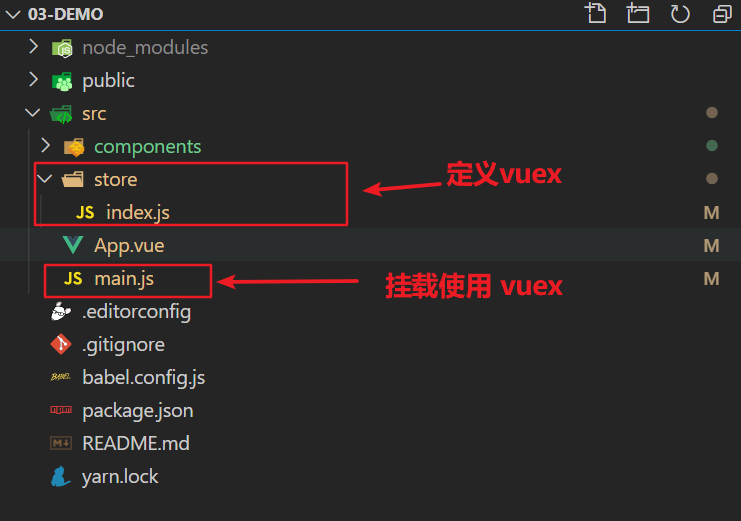
3 创建仓库 store/index.js
// 导入 vue
import Vue from 'vue'
// 导入 vuex
import Vuex from 'vuex'
// vuex也是vue的插件, 需要use一下, 进行插件的安装初始化
Vue.use(Vuex)
// 创建仓库 store
const store = new Vuex.Store()
// 导出仓库
export default store
2
3
4
5
6
7
8
9
10
11
12
4 在main.js 中导入挂载到 Vue 实例上
import Vue from 'vue'
import App from './App.vue'
import store from './store'
Vue.config.productionTip = false
new Vue({
render: h => h(App),
store
}).$mount('#app')
2
3
4
5
6
7
8
9
10
此刻起, 就成功创建了一个 空仓库!!
# 2.3 核心概念 - state 状态
State提供唯一的公共数据源,所有共享的数据都要统一放到Store中的State中存储。
打开项目中的store.js文件,在state对象中可以添加我们要共享的数据。
// 创建仓库 store
const store = new Vuex.Store({
// state 状态, 即数据, 类似于vue组件中的data,
// 区别在于 data 是组件自己的数据, 而 state 中的数据整个vue项目的组件都能访问到
state: {
count: 101
}
})
2
3
4
5
6
7
8
问题: 如何在组件中获取count?
- 插值表达式
{{ `$store.state.count` }}
mapState映射计算属性
{{ count }}
1 原始形式- 插值表达式
App.vue
组件中可以使用 this.$store 获取到vuex中的store对象实例,可通过**state属性属性获取count**, 如下
<h1>state的数据 - {{ $store.state.count }}</h1>
计算属性 - 将state属性定义在计算属性中 https://vuex.vuejs.org/zh/guide/state.html
// 把state中数据,定义在组件内的计算属性中
computed: {
count () {
return this.$store.state.count
}
}
2
3
4
5
6
<h1>state的数据 - {{ count }}</h1>
但是每次, 都这样一个个的提供计算属性, 太麻烦了, 所以我们需要辅助函数 mapState 帮我们简化语法
2 辅助函数 - mapState
mapState是辅助函数,帮助我们把store中的数据映射到 组件的计算属性中, 它属于一种方便的用法
用法 :
第一步:导入mapState (mapState是vuex中的一个函数)
import { mapState } from 'vuex'
第二步:采用数组形式引入state属性
mapState(['count'])
上面代码的最终得到的是 类似于
count () {
return this.$store.state.count
}
2
3
第三步:利用展开运算符将导出的状态映射给计算属性
computed: {
...mapState(['count'])
}
2
3
<div> state的数据:{{ count }}</div>
# 2.4 核心概念 - mutations
# 2.4.1 基本使用
通过 strict: true 可以开启严格模式
state数据的修改只能通过mutations,并且mutations必须是同步的
定义mutations
const store = new Vuex.Store({
state: {
count: 0
},
// 定义mutations
mutations: {
}
})
2
3
4
5
6
7
8
9
格式说明
mutations是一个对象,对象中存放修改state的方法
mutations: {
// 方法里参数 第一个参数是当前store的state属性
// payload 载荷 运输参数 调用mutaiions的时候 可以传递参数 传递载荷
addCount (state) {
state.count += 1
}
},
2
3
4
5
6
7
组件中提交 mutations
this.$store.commit('addCount')
解决问题: 两个子组件, 添加操作 add, addN 实现
# 2.4.2 带参数的 mutation
需求: 父组件也希望能改到数据
提交 mutation 是可以传递参数的 this.$store.commit('xxx', 参数)
1 提供mutation函数
mutations: {
...
inputCount (state, count) {
state.count = count
}
},
2
3
4
5
6
2 注册事件
<input type="text" :value="count" @input="handleInput">
3 提交mutation
handleInput (e) {
this.$store.commit('inputCount', +e.target.value)
}
2
3
小tips: 提交的参数只能是一个, 如果有多个参数要传, 可以传递一个对象
this.$store.commit('inputCount', {
count: e.target.value
})
2
3
解决问题: addN 的实现
# 2.4.3 辅助函数 - mapMutations
mapMutations和mapState很像,它把位于mutations中的方法提取了出来,我们可以将它导入
import { mapMutations } from 'vuex'
methods: {
...mapMutations(['addCount'])
}
2
3
4
上面代码的含义是将mutations的方法导入了methods中,等价于
methods: {
// commit(方法名, 载荷参数)
addCount () {
this.$store.commit('addCount')
}
}
2
3
4
5
6
此时,就可以直接通过this.addCount调用了
<button @click="addCount">值+1</button>
但是请注意: Vuex中mutations中要求不能写异步代码,如果有异步的ajax请求,应该放置在actions中
# 2.5 核心概念-actions
state是存放数据的,mutations是同步更新数据 (便于监测数据的变化, 更新视图等, 方便于调试工具查看变化),
actions则负责进行异步操作
需求: 一秒钟之后, 要给一个数 去修改state

定义actions
actions: {
setAsyncCount (context, num) {
// 一秒后, 给一个数, 去修改 num
setTimeout(() => {
context.commit('inputCount', num)
}, 1000)
}
},
2
3
4
5
6
7
8
原始调用 - $store (支持传参)
setAsyncCount () {
this.$store.dispatch('setAsyncCount', 200)
}
2
3
辅助函数 -mapActions
actions也有辅助函数,可以将action导入到组件中
import { mapActions } from 'vuex'
methods: {
...mapActions(['setAsyncCount'])
}
2
3
4
直接通过 this.方法 就可以调用
<button @click="setAsyncCount(200)">+异步</button>
# 2.6 核心概念-getters
除了state之外,有时我们还需要从state中派生出一些状态,这些状态是依赖state的,此时会用到getters
例如,state中定义了list,为1-10的数组,
state: {
list: [1, 2, 3, 4, 5, 6, 7, 8, 9, 10]
}
2
3
组件中,需要显示所有大于5的数据,正常的方式,是需要list在组件中进行再一步的处理,但是getters可以帮助我们实现它
定义getters
getters: {
// getters函数的第一个参数是 state
// 必须要有返回值
filterList: state => state.list.filter(item => item > 5)
}
2
3
4
5
使用getters
原始方式 -$store
<div>{{ $store.getters.filterList }}</div>
辅助函数 - mapGetters
computed: {
...mapGetters(['filterList'])
}
2
3
<div>{{ filterList }}</div>
# 2.7 核心概念 - 模块 module (进阶拓展)
由于使用单一状态树,应用的所有状态会集中到一个比较大的对象。当应用变得非常复杂时,store 对象就有可能变得相当臃肿。
这句话的意思是,如果把所有的状态都放在state中,当项目变得越来越大的时候,Vuex会变得越来越难以维护
由此,又有了Vuex的模块化
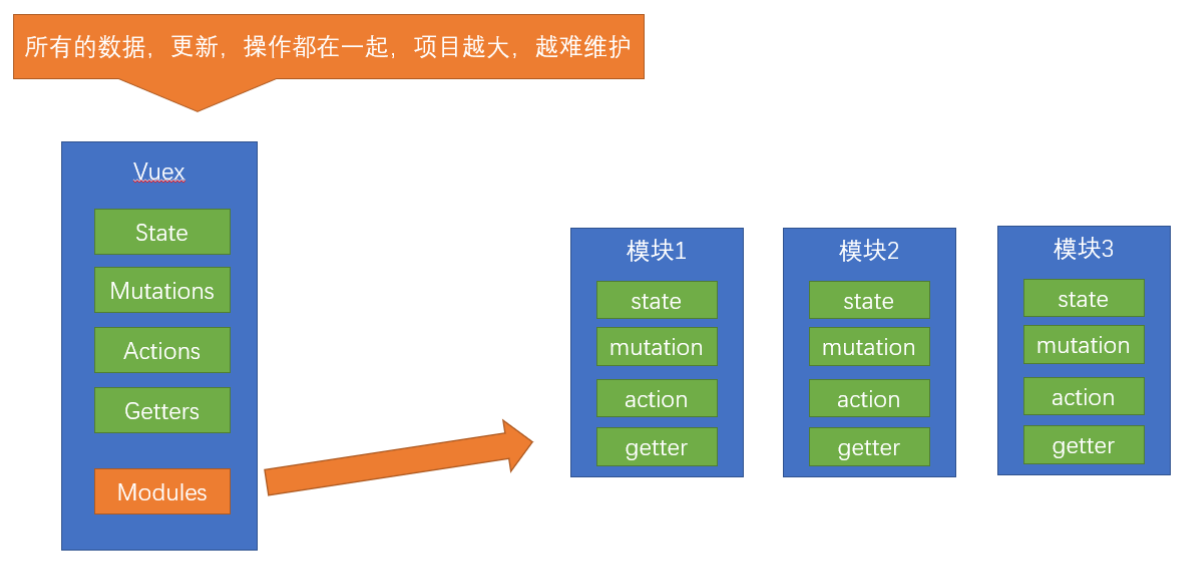
# 2.7.1 模块定义 - 准备 state
定义两个模块 user 和 setting
user中管理用户的信息状态 userInfo modules/user.js
const state = {
userInfo: {
name: 'zs',
age: 18
}
}
const mutations = {}
const actions = {}
const getters = {}
export default {
state,
mutations,
actions,
getters
}
2
3
4
5
6
7
8
9
10
11
12
13
14
15
16
17
18
19
20
setting中管理项目应用的名称 title, desc modules/setting.js
const state = {
title: '这是大标题',
desc: '描述真呀真不错'
}
const mutations = {}
const actions = {}
const getters = {}
export default {
state,
mutations,
actions,
getters
}
2
3
4
5
6
7
8
9
10
11
12
13
14
15
16
17
使用模块中的数据, 可以直接通过模块名访问 $store.state.模块名.xxx => $store.state.setting.title
也可以通过 mapState 映射
# 2.7.2 命名空间 namespaced
默认情况下,模块内部的 action、mutation 和 getter 是注册在全局命名空间的
这句话的意思是 刚才的 user模块 还是 setting模块,它的 action、mutation 和 getter 其实并没有区分,都可以直接通过全局的方式调用, 如下图所示:
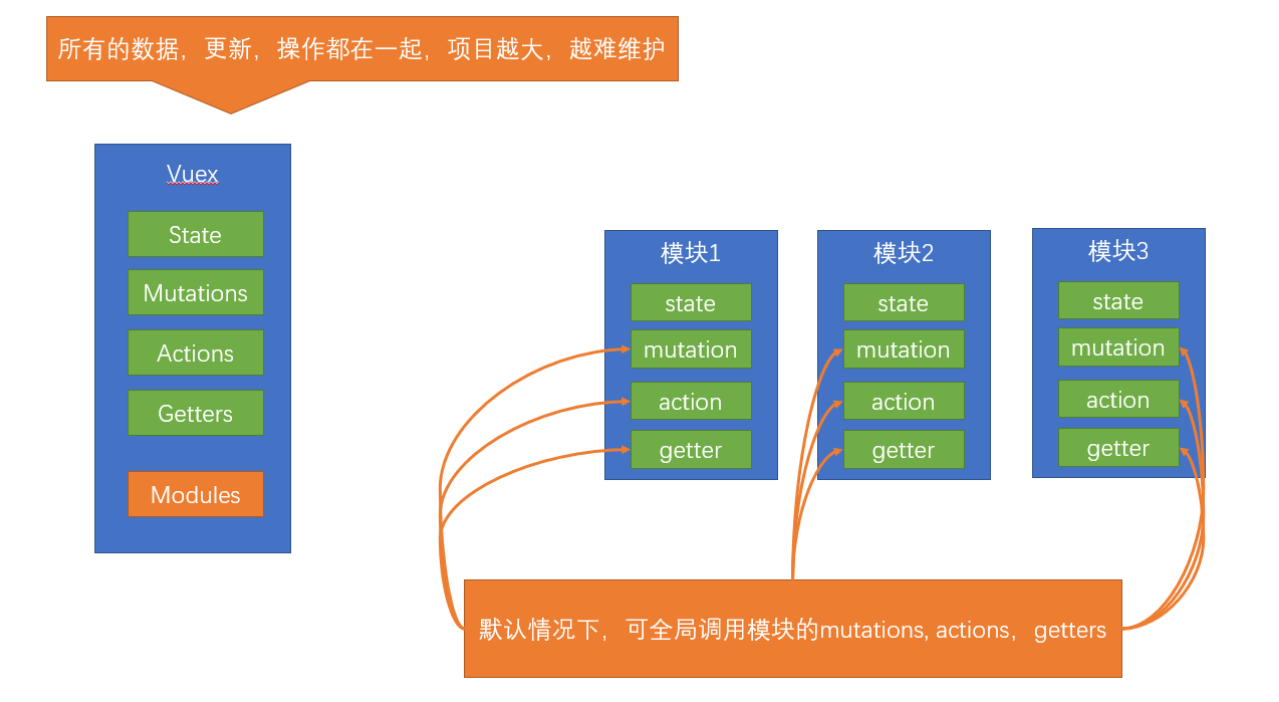
但是,如果我们想保证内部模块的高封闭性,我们可以采用namespaced来进行设置
modules/user.js
const state = {
userInfo: {
name: 'zs',
age: 18
},
myMsg: '我的数据'
}
const mutations = {
updateMsg (state, msg) {
state.myMsg = msg
}
}
const actions = {}
const getters = {}
export default {
namespaced: true,
state,
mutations,
actions,
getters
}
2
3
4
5
6
7
8
9
10
11
12
13
14
15
16
17
18
19
20
21
22
23
24
25
提交模块中的mutation
全局的: this.$store.commit('mutation函数名', 参数)
模块中的: this.$store.commit('模块名/mutation函数名', 参数)
2
3
namespaced: true 后, 要添加映射, 可以加上模块名, 找对应模块的 state/mutations/actions/getters
computed: {
// 全局的
...mapState(['count']),
// 模块中的
...mapState('user', ['myMsg']),
},
methods: {
// 全局的
...mapMutations(['addCount'])
// 模块中的
...mapMutations('user', ['updateMsg'])
}
2
3
4
5
6
7
8
9
10
11
12
# 3 综合案例 - 购物车
# 3.1 创建项目
脚手架新建项目 (注意:勾选vuex)
版本说明:vue2 vue-router3 vuex3 vue3 vue-router4
vuex4/pinia
vue create vue-cart-demo
- 将原本src内容清空,替换成教学资料的
《vuex-cart-准备代码》
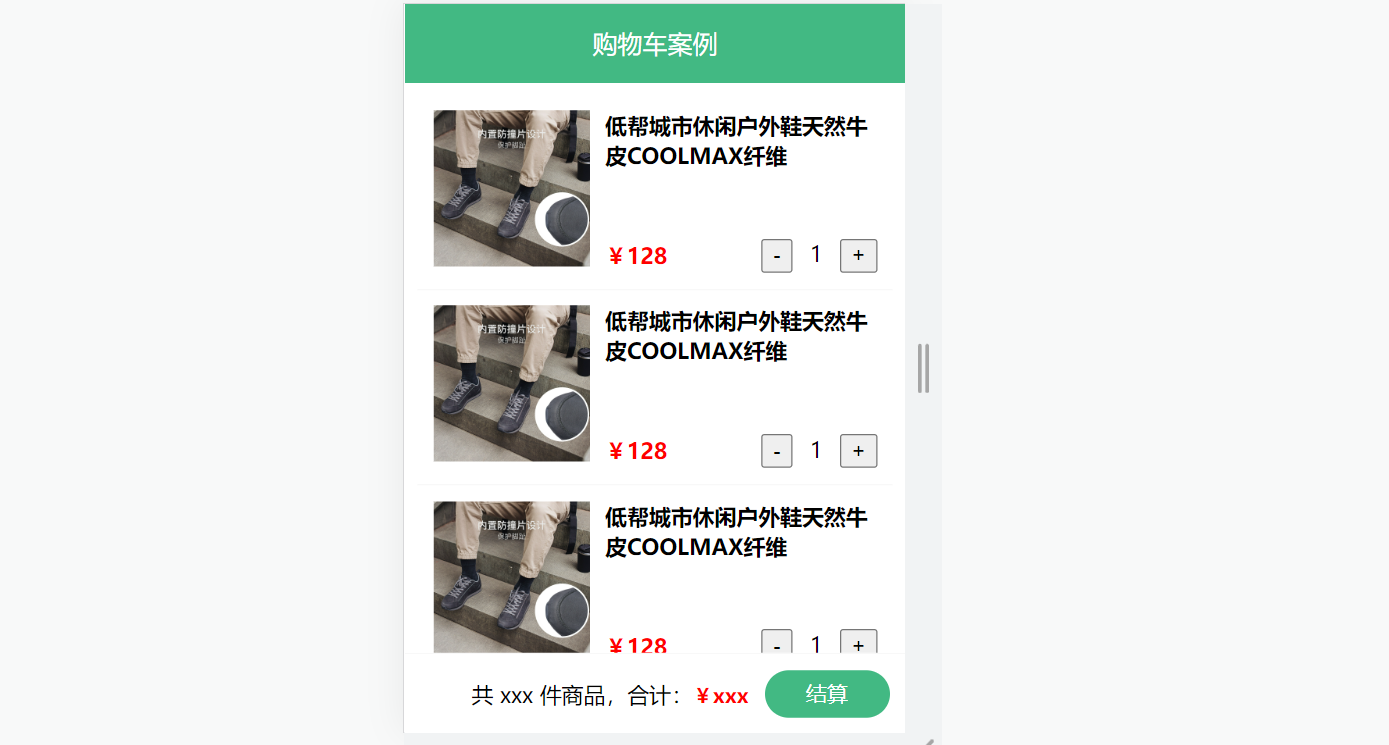
需求:
- 发请求动态渲染购物车,数据存vuex (存cart模块, 将来还会有user模块,article模块...)
- 可以修改数据
- 动态计算总价和总数量
# 3.2 构建vuex-cart模块
- 新建
store/modules/cart.js
export default {
namespaced: true,
state () {
return {
list: []
}
},
}
2
3
4
5
6
7
8
- 挂载到 vuex 仓库上
store/cart.js
import Vuex from 'vuex'
import Vue from 'vue'
import cart from './modules/cart'
Vue.use(Vuex)
const store = new Vuex.Store({
modules: {
cart
}
})
export default store
2
3
4
5
6
7
8
9
10
11
12
13
14
# 3.3 准备后端接口服务环境(了解)
- 安装全局工具 json-server (全局工具仅需要安装一次)
yarn global add json-server 或 npm i json-server -g
- 代码根目录新建一个 db 目录
- 将资料 index.json 移入 db 目录
- 进入 db 目录,执行命令,启动后端接口服务
json-server index.json
# 3.4 请求动态渲染数据
- 安装 axios
yarn add axios
- 准备actions 和 mutations
import axios from 'axios'
export default {
namespaced: true,
state () {
return {
list: []
}
},
mutations: {
updateList (state, payload) {
state.list = payload
}
},
actions: {
async getList (ctx) {
const res = await axios.get('http://localhost:3000/cart')
ctx.commit('updateList', res.data)
}
}
}
2
3
4
5
6
7
8
9
10
11
12
13
14
15
16
17
18
19
20
21
App.vue页面中调用 action, 获取数据
import { mapState } from 'vuex'
export default {
name: 'App',
components: {
CartHeader,
CartFooter,
CartItem
},
created () {
this.$store.dispatch('cart/getList')
},
computed: {
...mapState('cart', ['list'])
}
}
2
3
4
5
6
7
8
9
10
11
12
13
14
15
16
- 动态渲染
<!-- 商品 Item 项组件 -->
<cart-item v-for="item in list" :key="item.id" :item="item"></cart-item>
2
cart-item.vue
<template>
<div class="goods-container">
<!-- 左侧图片区域 -->
<div class="left">
<img :src="item.thumb" class="avatar" alt="">
</div>
<!-- 右侧商品区域 -->
<div class="right">
<!-- 标题 -->
<div class="title">{{item.name}}</div>
<div class="info">
<!-- 单价 -->
<span class="price">¥{{item.price}}</span>
<div class="btns">
<!-- 按钮区域 -->
<button class="btn btn-light">-</button>
<span class="count">{{item.count}}</span>
<button class="btn btn-light">+</button>
</div>
</div>
</div>
</div>
</template>
<script>
export default {
name: 'CartItem',
props: {
item: Object
},
methods: {
}
}
</script>
2
3
4
5
6
7
8
9
10
11
12
13
14
15
16
17
18
19
20
21
22
23
24
25
26
27
28
29
30
31
32
33
34
35
# 3.5 修改数量
- 注册点击事件
<!-- 按钮区域 -->
<button class="btn btn-light" @click="onBtnClick(-1)">-</button>
<span class="count">{{item.count}}</span>
<button class="btn btn-light" @click="onBtnClick(1)">+</button>
2
3
4
- 页面中dispatch action
onBtnClick (step) {
const newCount = this.item.count + step
if (newCount < 1) return
// 发送修改数量请求
this.$store.dispatch('cart/updateCount', {
id: this.item.id,
count: newCount
})
}
2
3
4
5
6
7
8
9
10
- 提供action函数
async updateCount (ctx, payload) {
await axios.patch('http://localhost:3000/cart/' + payload.id, {
count: payload.count
})
ctx.commit('updateCount', payload)
}
2
3
4
5
6
- 提供mutation处理函数
mutations: {
...,
updateCount (state, payload) {
const goods = state.list.find((item) => item.id === payload.id)
goods.count = payload.count
}
},
2
3
4
5
6
7
# 3.6 底部总价展示
- 提供getters
getters: {
total(state) {
return state.list.reduce((p, c) => p + c.count, 0);
},
totalPrice (state) {
return state.list.reduce((p, c) => p + c.count * c.price, 0);
},
},
2
3
4
5
6
7
8
- 动态渲染
<template>
<div class="footer-container">
<!-- 中间的合计 -->
<div>
<span>共 {{total}} 件商品,合计:</span>
<span class="price">¥{{totalPrice}}</span>
</div>
<!-- 右侧结算按钮 -->
<button class="btn btn-success btn-settle">结算</button>
</div>
</template>
<script>
import { mapGetters } from 'vuex'
export default {
name: 'CartFooter',#
computed: {
...mapGetters('cart', ['total', 'totalPrice'])
}
}
</script>
2
3
4
5
6
7
8
9
10
11
12
13
14
15
16
17
18
19
20
21

